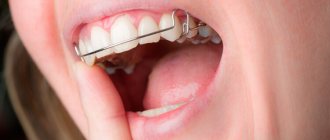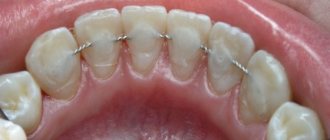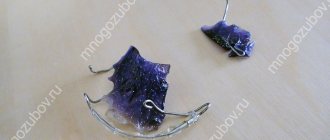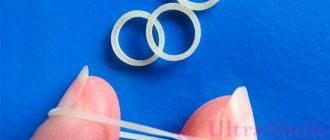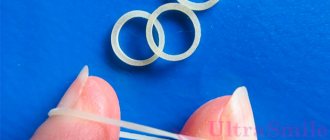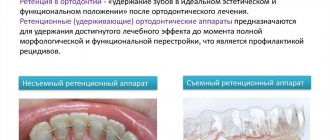Publication date: June 01, 2022.
Information on this page was updated on December 30, 2021.
Orthodontic treatment does not end with the removal of braces, because immediately after removal, the bone tissue and ligaments will begin to return to their original position and move the teeth. To consolidate the result after removing braces, it is necessary to install retention structures that will hold the teeth in the correct position until the bone tissue is finally formed around the roots of the teeth.
- What are retainers?
- Fixed retainers
- Removable retainers and mouthguards
- Combined
- How do retainers work?
- How long should retainers be worn?
- The process of installing permanent retainers
- How to care for retainers?
- Which is better: mouthguards or retainers?
- Frequently asked questions about retainers
- What problems can arise with a retainer?
- Reviews about retainers
Fixed retainers
A permanent retainer is a wire arch made of medical steel, which is attached to the inside of the teeth with a special compound. This type of retainer is used most often, as they are completely invisible, cannot be felt in the mouth and do not oxidize. Fixed retainers can come off due to mechanical stress, such as chewing hard food. In this case, you should immediately visit the orthodontist and return the retainer to its place to prevent the teeth from moving.
Fixed retainers have many advantages: you can’t forget to put them on - they are always on your teeth, and they are absolutely invisible and do not interfere. The main feature of wearing a fixed structure is the need for careful home hygiene and professional cleaning every six months at the dentist, since plaque in hard-to-reach places around the retainer is more difficult to clean.
Is it possible to remove the structure yourself?
As for such dental retainers, which are removable, everything is simple - they can be removed from the mouth independently. But in no case should you do this with non-removable ones, because... this can cause damage not only to the structure itself, but also to the enamel of your teeth. Such systems should only be crushed by the orthodontist who fixed them. How does this process happen? At the appointment, a specialist carefully cuts off the wire with a special tool and peels off the intermediate elements of the system (usually, they are carefully cut off with a bur). Next, the specialist cleans your enamel, applies a composite material to close the grooves and polishes the surface of the teeth.
The structure can only be removed by a specialist
Removable retainers and mouthguards
Removable retention structures come in two types:
- Plastic plates with a metal arch that encircles the dentition;
- Transparent mouth guards made of silicone.
After braces are removed, mouthguards or plates must be worn constantly, removed only during meals, brushing teeth, or public speaking. In the future, on the recommendation of a doctor, the time of wearing retention structures is reduced: they are removed at night and worn less during the day. Removable structures can be noticeable to others, and at first they affect diction and cause increased salivation. Typically, removable retainers are prescribed at the end of the retention period after fixed structures, but they can also be used independently throughout the entire retention period.
Plastic plates with metal arc
Silicone transparent mouth guard
Conclusions. Expert advice
The retention period is a very important part of correcting dental pathologies. If the patient behaves incorrectly at this time, the effect may well come to naught. The problem can be prevented using special removable or non-removable devices. They are called retainers.
Main features of orthodontic appliances:
- Requires regular wear for several years.
- They can be removed or attached to the teeth for life - it depends on the patient and the characteristics of his body.
- They require special attention to oral hygiene, the use of an irrigator and brushes.
- They must be worn under the supervision of a specialist.
Doctors know that it is the dental retainer that keeps the bite in the correct state until the muscles get used to the new position of the molars, incisors and canines. It is mandatory to wear the device. If problems arise with any type of orthodontic design, you can always choose another option that will better suit the patient.
How do retainers work?
Braces or aligners actively move teeth in the desired direction due to the traction of the arch and pressure on the dentition. A non-removable wire retainer does not put pressure on the teeth, but only holds them in the desired position, preventing them from moving apart. Removable aligners differ from aligners in that they are not used with attachments (activators of tooth movement), but exactly repeat the shape of the dentition and fit tightly to the teeth, fixing the dentition. Any retention structure does not move the teeth, but at the same time it should prevent the ligaments from relaxing and returning to their previous position until the bone tissue around is completely strengthened.
How long should retainers be worn?
The duration of the retention period is on average 2 times longer than wearing braces, and patients who corrected their bite in adulthood - after 25-30 years, can wear retainers all their lives.
The length of time you wear retainers usually varies from person to person and depends on the following factors:
- Age of the orthodontic patient. The younger a person is, the faster his ligaments and muscles are rebuilt, thereby fixing the teeth and bite in the correct position. For patients who received braces as teenagers, wearing retainers for 6 months to 2 years is sometimes sufficient.
- Bad habits. People who smoke have poor blood supply and reduced immunity, so all processes of restructuring the position of teeth and healing are slower than in non-smokers.
- Oral health. If the teeth and periodontal tissues are healthy, the fixation of the ligamentous apparatus occurs faster.
- Complexity of the clinical case. The stronger the initial curvature of the teeth, the longer you need to wear a retainer.
The retention period must be carried out under the supervision of an orthodontist so that he monitors the condition of the bite. In any case, you should not stop wearing retainers without your doctor's approval, otherwise your teeth may become crooked again.
The process of installing permanent retainers
Retainers are installed after braces are removed on completely healthy teeth after professional hygiene. The patient may need to undergo oral sanitation after orthodontic treatment. While wearing braces, it is difficult to clean your teeth perfectly, and accumulated plaque can cause caries and tartar. Retainers cannot be installed on affected teeth, since another design in the mouth will again complicate hygiene and lead to a deterioration in the condition of the oral cavity. Also, during orthodontic treatment, the enamel may become thinner, so in addition to hygienic cleaning, teeth need fluoridation and mineralization.
After carrying out therapeutic and preventive measures, the orthodontist begins the laboratory stage of manufacturing retainers. An impression is taken from healthy teeth, according to which the retainer is given the necessary shape of the dentition.
Before the actual installation of the retainer, the teeth are etched with a special solution so that their surface becomes slightly rougher for better adhesion. In some cases, instead of etching the teeth, the teeth are prepared: a microgroove is drilled on the inside to fix the retainer. Once the teeth are prepared, the retainer is placed in the desired position and secured with composite material. The procedure is completed by grinding the material for the patient’s convenience.
The installation procedure takes 15-20 minutes and is absolutely painless. But in the first days of adaptation, the retainer can rub and reduce the clarity of diction.
Removal
Only the doctor who is observing the patient should remove orthodontic structures. He also decides to change the wearing regime of orthodontic splints. The procedure for removing structures from the oral cavity takes from 10 to 20 minutes. First, the doctor cuts the wire fastenings, and then carefully peels off the fixing parts.
There is a fee for removing fixed retainers.
The enamel coating needs to be thoroughly cleaned of the adhesive, so the doctor polishes it. If the enamel has been severely damaged, procedures are prescribed to restore the enamel coating. It is prohibited to remove fixed orthodontic mechanisms yourself: you can seriously damage the enamel layer.
How to care for retainers?
Retainers, like any structure in the mouth, without careful hygiene provoke the accumulation of bacteria, the appearance of plaque and caries.
- You can brush your teeth with a regular toothbrush and toothpaste, but be careful when brushing the inside of your teeth if you have a permanent retainer;
- If the retainer comes unstuck, you need to visit the orthodontist and return it to its place so that an orthodontic relapse does not occur;
- For thorough hygiene when wearing fixed retainers, it is recommended to use a waterpik, brushes and dental floss to clean hard-to-reach places near the arch;
- Removable retainers and mouth guards should be washed with disinfectants, soap, or brushed with toothpaste at least 2 times a day.
- Mouthguards must be removed when eating and smoking and stored in special containers;
- Mouthguards should not be washed with hot water because they will become deformed.
- To strengthen the enamel, it is recommended to rinse the mouth with a fluoride solution.
After braces are removed and retainers are installed, you should periodically visit the orthodontist for follow-up examinations and the hygienist to maintain oral health. Only after the end of the retention period can orthodontic treatment be considered complete.
Principle of operation
The use of a brace system is accompanied by a restructuring of the dentofacial apparatus. Damaged collagen fibers in the alveolar ridge and gum tissue are unable to repair themselves while the units are under pressure from the device. Stabilization of the unit in a given position and the formation of new tissues occurs after six months to a year. To prevent relapse after braces are removed, retainers are used.
Typically, an orthodontic permanent retainer is installed on both jaws. A thin metal wire or tape with the help of a filling compound is fixed on six units in the frontal area from the inside. The installation process is simple and painless. The procedure takes on average up to 30 minutes.
The wire does not cause discomfort. There are no diction defects or disturbances in the process of chewing food. The maximum adaptation period is 7 days.
Which is better: mouthguards or retainers?
Retention mouthguards and a non-removable retainer after orthodontic treatment are used in combination: a non-removable retainer from canine to fang is permanently placed on the teeth, the mouthguard is put on at night. After removing braces, we give patients 2 mouthguards: a night guard for all teeth in the upper dentition and a canine-to-canine safety mouthguard for the lower dentition, which is needed if the retainer breaks and there is no way to quickly make an appointment with an orthodontist. From the point of view of patient comfort, a non-removable retainer is more convenient than a mouth guard, since a week after installation, it is practically not felt in the mouth. And the mouth guards are quite bulky and it’s more difficult to get used to them.
Manufacturing
Orthodontic structures are made from individual impressions taken from patients. The process of creating a model takes from 2 to 7 days.
Stages of manufacturing an orthodontic product:
- taking an impression;
- production and 3D scanning of the model;
- 3d printing of jaw;
- creation of a transparent mouthguard on a press former.
There are also standard retainers in the form of plates, which, when fixed, are adjusted to the patient’s jaw. But this method is inferior in effectiveness to the individual approach.
Frequently asked questions about retainers:
Typically, patients who are thinking about installing braces learn about the need to wear a retainer during a consultation with an orthodontist. We have collected the most common questions that patients ask about the retention period.
How long to wear a retainer?
The minimum period for an adult patient is twice as long as the period of orthodontic treatment. Our recommended period is from 5 to 10 years, depending on the complexity of the case and the type of retention. Many patients do not feel the retainer on their teeth and quietly wear it all their lives.
Is it possible to do an MRI with a retainer?
Yes, an MRI can be done with a retainer, just like with braces, but due to the presence of metal in the mouth, there may be interference in the final image.
Do I need to change my permanent retainer?
If the retainer is not broken or unstuck, then there is no need to change it. To maintain good hygiene in the retainer area, use a single-tuft brush, brushes, dental floss, and regular professional hygiene.
Is there a warranty for the retainer?
In our clinic, the warranty on the retainer lasts 2 years. If during this time the retainer breaks or comes off, we will replace it absolutely free of charge.
Can teeth move apart if a retainer is installed?
If orthodontic treatment is completed correctly - the correct closure and position of the teeth is achieved, then with a permanent retainer, the teeth will remain in the correct position. If the retainer comes unstuck or breaks, you need to install it as quickly as possible, since even in a month your teeth can change position.
What problems can arise with a retainer?
The first thing a person who has a permanent retainer installed will face is getting used to it. At first, the retainer may rub your tongue, feel too big in your mouth, and interfere with clear diction. The retainer becomes invisible in the mouth after about a week.
The next task for a patient with a retainer is careful home hygiene, since food debris can get stuck in the spaces between the teeth and the retainer. For home cleaning, we recommend using a single-tuft brush, brushes, dental floss and irrigator.
The retainer may break or come off due to hard foods. In this case, you need to contact your doctor for a replacement.
If caries appears in the area of the retainers on the teeth, then for treatment by a therapist, the retainer will need to be removed and then reinstalled.
